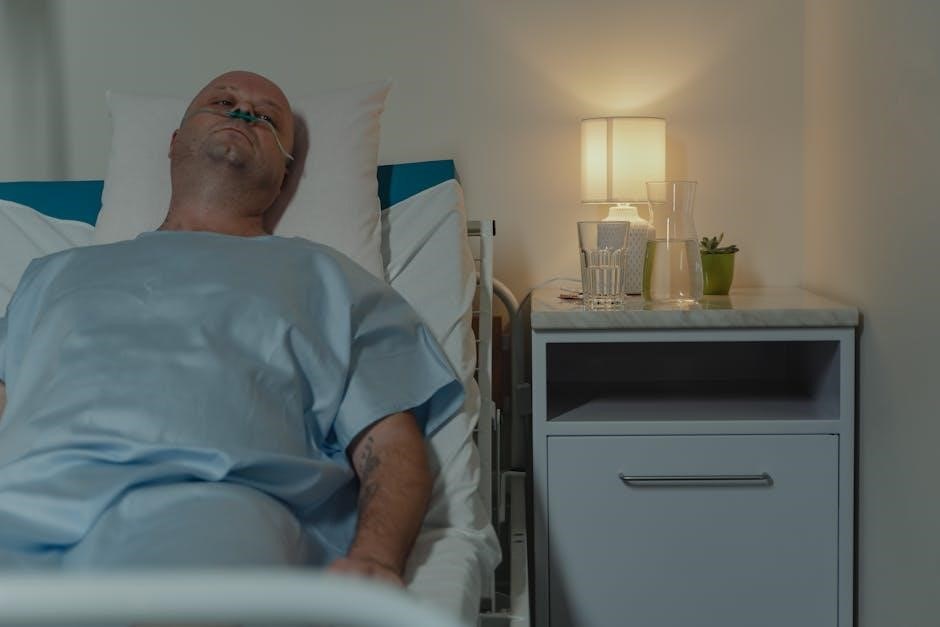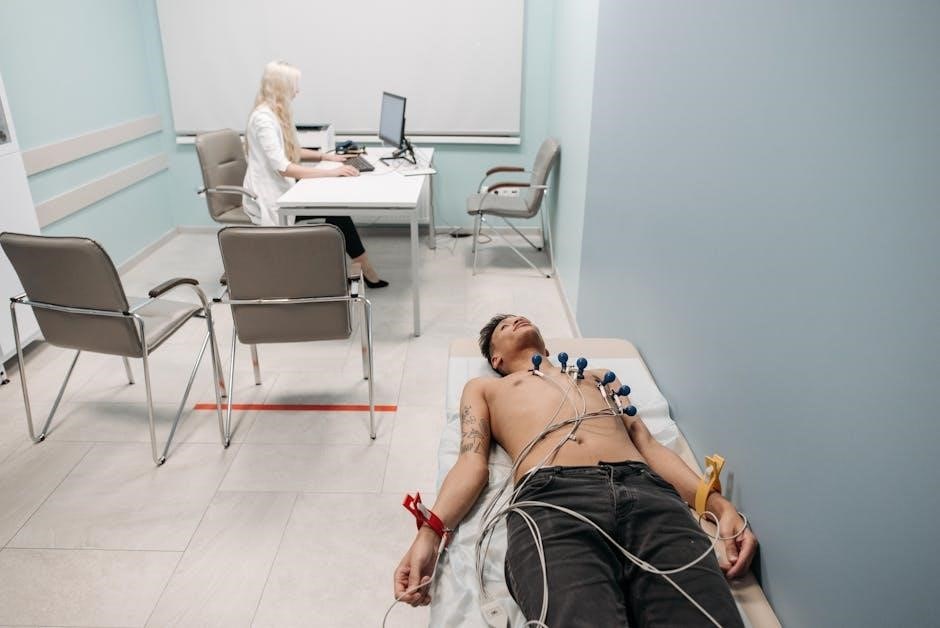The Invacare hospital bed instruction manual provides guidance on using and maintaining hospital beds, including the Semi-Electric Bed, with its pendant control and manual crank, for optimal patient care and safety features always.

Overview of Invacare Hospital Bed Models
Invacare hospital bed models are designed to provide comfort and support for patients in various healthcare settings. The Semi-Electric Bed is a popular model, offering motorized positioning of the upper body and knees, with a manual crank for bed height adjustment. Other models, such as the Full Electric Bed, are also available, featuring advanced technology and safety features. Invacare hospital beds are designed to meet the needs of patients and caregivers, with a focus on safety, comfort, and ease of use. The beds are constructed with durable materials and are designed to withstand heavy use. Invacare offers a range of bed models, each with its own unique features and benefits, allowing healthcare providers to choose the best bed for their specific needs. The company’s commitment to quality and innovation has made Invacare a leading manufacturer of hospital beds, with a reputation for excellence in the healthcare industry. Invacare hospital beds are used in hospitals, nursing homes, and other healthcare facilities around the world;
Key Features of Invacare Hospital Beds
Invacare hospital beds are designed with key features that prioritize patient comfort and safety. The beds have a sleep surface area of 80 inches in length and 36 inches in width, providing ample space for patients to rest comfortably. The bed frame height adjustment ranges from 15 to 23 inches, allowing caregivers to easily access patients. Additionally, the beds have a shipping weight of 176 pounds, making them durable and sturdy. The Invacare hospital beds also comply with UL 962 and CSA certification standards, ensuring that they meet rigorous safety and quality requirements. Other key features include a pendant control for motorized positioning, a manual crank for bed height adjustment, and a durable construction that can withstand heavy use. These features work together to provide a safe and comfortable environment for patients, while also making it easier for caregivers to provide quality care. Invacare hospital beds are designed to meet the unique needs of patients and caregivers in various healthcare settings. The beds are constructed with high-quality materials and are designed to last. Invacare hospital beds are a popular choice among healthcare providers due to their reliability and performance.

Assembly and Installation of Invacare Hospital Beds
Invacare recommends two people for assembly, ensuring locking casters are attached diagonally for safety and proper installation always using manual instructions carefully.
Step-by-Step Assembly Instructions
To assemble the Invacare hospital bed, begin by unpacking and organizing all components, then attach the universal bed ends to the bed frame, ensuring proper alignment and secure locking. Next, install the headspring and footspring, followed by the bed motors and control system. The manual crank for bed height adjustment should be attached at the foot end of the bed. It is essential to follow the manufacturer’s instructions carefully and take necessary safety precautions to avoid injury or damage. Invacare recommends that two people perform the assembly procedure to ensure accuracy and efficiency. By following these step-by-step instructions, caregivers can ensure the Invacare hospital bed is properly assembled and ready for use, providing optimal support and comfort for patients. The assembly process requires attention to detail and adherence to safety guidelines to guarantee a safe and functional hospital bed.
Important Safety Precautions
When using the Invacare hospital bed, it is crucial to follow important safety precautions to prevent accidents and ensure patient well-being. The bed rails should not be used as restraints, and only Invacare-approved bed rails should be installed to avoid compatibility issues. Caregivers should also ensure that the bed is properly assembled and maintained, with all parts securely locked in place. Patients should be supervised at all times when using the bed, especially when adjusting the position or height. The manual crank for bed height adjustment should be used carefully to avoid pinching or crushing injuries. Additionally, the bed should be placed on a firm, level surface, away from any hazards or obstacles. By following these safety precautions, caregivers can minimize the risk of accidents and provide a safe and comfortable environment for patients using the Invacare hospital bed. Regular safety checks and training are also essential to ensure compliance with safety guidelines and regulations.

Operation and Maintenance of Invacare Hospital Beds
Invacare hospital beds require regular maintenance and operation checks for optimal performance and patient safety always ensured through proper use.
Understanding the Pendant Control
The pendant control is a crucial component of Invacare hospital beds, providing patients with easy access to adjust their position and comfort level. The control typically features a simple and intuitive interface, allowing patients to adjust the bed’s position with minimal effort. According to the Invacare hospital bed instruction manual, the pendant control is designed to be user-friendly, with clear labels and easy-to-use buttons. The control also often includes features such as a lockout function to prevent accidental adjustments. By understanding how to use the pendant control, patients and caregivers can ensure optimal use of the hospital bed, promoting comfort, safety, and independence. The pendant control is typically connected to the bed’s motorized system, allowing for smooth and quiet adjustments. Proper use of the pendant control is essential for maintaining the bed’s functionality and ensuring patient safety. Regular checks should be performed to ensure the control is functioning correctly.
Regular Maintenance Checks
Regular maintenance checks are essential to ensure the optimal functioning and safety of Invacare hospital beds. The Invacare hospital bed instruction manual recommends performing routine checks on the bed’s components, such as the frame, motors, and controls; This includes inspecting the bed’s moving parts, checking for any signs of wear or damage, and verifying that all screws and bolts are securely tightened. Additionally, the manual suggests checking the bed’s electrical components, such as the power cord and plugs, to ensure they are in good condition and functioning properly. By performing these regular maintenance checks, healthcare providers can help prevent accidents, reduce downtime, and extend the lifespan of the hospital bed. It is also important to keep a record of maintenance checks and any repairs or replacements made to the bed, as this can help track the bed’s history and ensure compliance with regulatory requirements. Proper maintenance is crucial for patient safety and comfort.

Troubleshooting Common Issues with Invacare Hospital Beds
Invacare hospital beds may experience issues, resolved through troubleshooting, ensuring optimal functionality and patient safety always with proper maintenance and repair techniques used.
Identifying and Resolving Common Problems
To identify and resolve common problems with Invacare hospital beds, it is essential to refer to the instruction manual and follow the troubleshooting guide. The manual provides a list of potential issues and their corresponding solutions, allowing caregivers to quickly and easily resolve problems. Some common issues include malfunctioning motors, faulty electronics, and worn-out parts. By following the troubleshooting guide, caregivers can identify the root cause of the problem and take corrective action to ensure the bed is functioning properly. Regular maintenance and inspection can also help prevent problems from occurring in the first place; Additionally, Invacare provides customer support and repair services to help resolve any issues that may arise. By taking a proactive approach to maintenance and troubleshooting, caregivers can ensure that Invacare hospital beds continue to provide optimal support and comfort for patients. This helps to prevent accidents and injuries, and ensures a safe and healthy environment for patients.
Warranty and Support Information
Invacare hospital beds come with a comprehensive warranty and support program, providing caregivers with peace of mind and protection against defects and malfunctions. The warranty covers parts and labor for a specified period, and Invacare also offers extended warranty options for added protection. In addition to the warranty, Invacare provides dedicated customer support, including phone and email support, to help caregivers with any questions or issues they may have. The company also offers online resources, including user manuals, troubleshooting guides, and FAQs, to help caregivers quickly and easily find the information they need. Furthermore, Invacare has a network of authorized service providers who can provide repair and maintenance services for hospital beds. By providing comprehensive warranty and support information, Invacare helps ensure that caregivers have the resources they need to provide optimal care and support for patients, and to maintain the hospital bed in good working condition. This information is readily available on the Invacare website and in the instruction manual.
